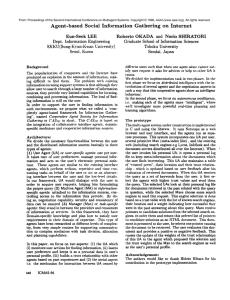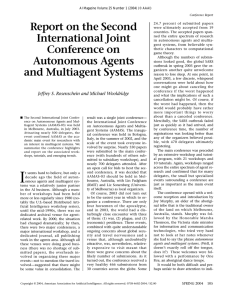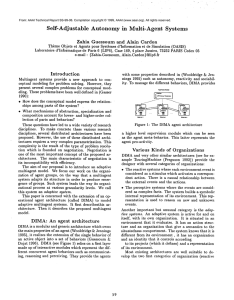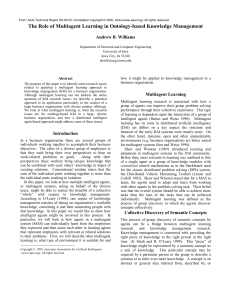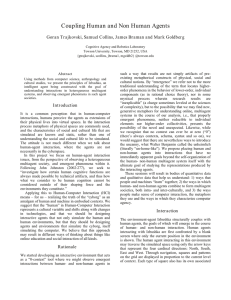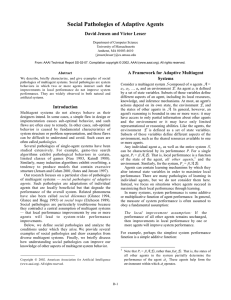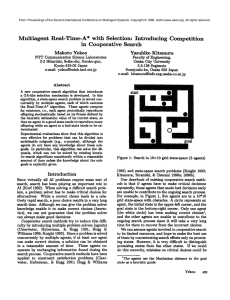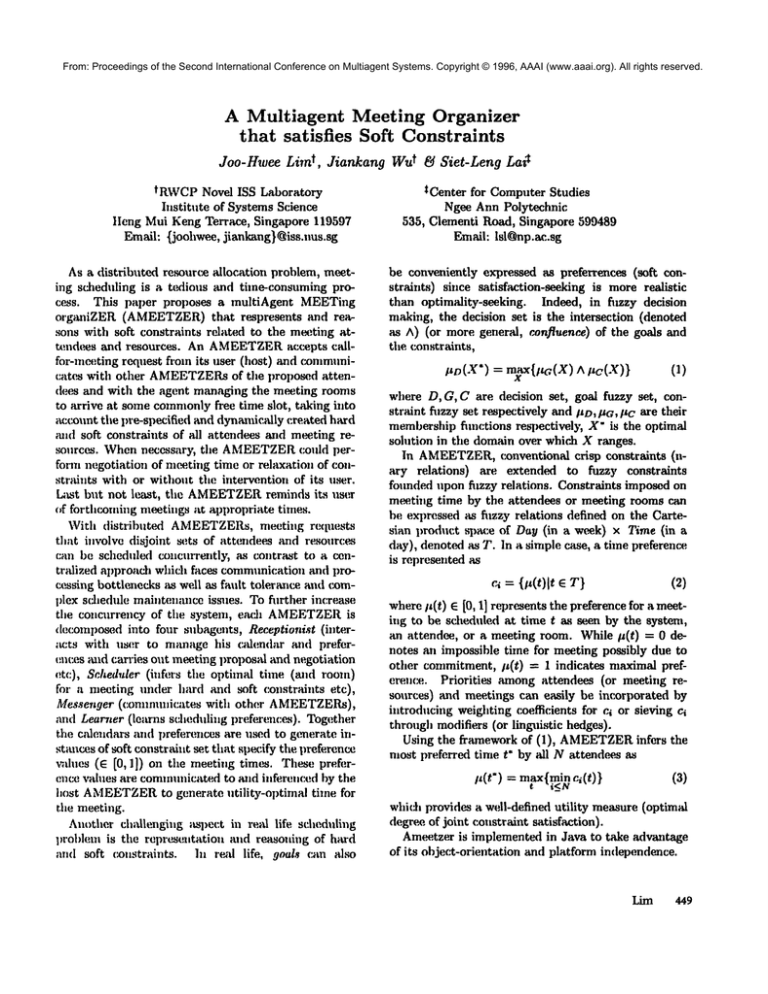
From: Proceedings of the Second International Conference on Multiagent Systems. Copyright © 1996, AAAI (www.aaai.org). All rights reserved.
A Multiagent Meeting Organizer
that satisfies
Soft Constraints
Joo-Hwee Lira t,
JiankangWut ~f~
tRWCPNovel ISS Laboratory
Institute of Systems Science
IIeng Mui Keng Terrace, Singapore 119597
Email: (joohwee, jiankang}@iss.nus.sg
As a distrihuted resour(~ allocation problem, meeting sdmduling is a tedious and time-consuming process. This paper proposes a multiAgent MEETing
organiZER (AMEETZER)that respresents
and reasons with soft constraints related to the meeting att~mdees and resources. An AMEETZER
accepts callfor-meeting
request
fron|itsuser(host)
andconmmnicateswithotherAMEETZERsof the proposedattendeesand withthe agentmanagingthe meetingrooms
to arriveat somecommonly
freetimeslot,takinginto
~u:count
thepre-specified
anddynmnically
created
hard
andsoftconstraints
of allattendees
andmeeting
resources.Whcn necessar);the AMEETZERcouldperformnegotiation
of mc~.ting
timeor relaxation
of constraints
withor without
theintervention
of itsuser.
Lastbut not least,the AMEETZERremindsits user
of forthcondng meetings aC appropriate times.
With distrihuted
AMEETZERs,meeting requests
that involve disjoint se.ts of attendees and resources
can be scheduled concurrently, as contrast to a centralized approadl which faces conmnmication and procrossing bottlenecks as well as fanlt tolerance mid complex scheduh., maintemmceissues. To filrther increase
the concurrency of the system, eacJl AMEETZER
is
dc~composedinto four subagents, Receptionist (inter~:ts with user to manage his calendar and prefercnces and can’ies out meeting proposal and negotiation
ctc), Scheduler (infers the optimal time (and room)
for a meeting under hard and .soft constraints etc),
Messenger (connmmic:~tes with other AMEETZERs),
and Learner (learns scheduling preferences). Together
the calendm’s and preferences are used to g~merate instmme.sof soft constraint set that specify the preferv.nce
-~tlues (E [0, l]) on the meeting times. These prefi~.r
once values are conmnmicatedto and inferenced by the
host AMEETZER
to generate utility-optimal
time for
the meeting.
Another challenging asl)eCt in real life scheduling
l~rohlem is the representation mid reasoning of hard
and soft constraints.
In real life, goal.s can also
Siet-Leng
Lag
~Center for ComputerStudies
Ngee Ann Polytechnic
535, Clementi Road, Singapore 599489
Email: lsl@np.ac.sg
be conveniently expressed as preferrences (soft constraints) since satisfaction-seeking is more realistic
than optimality-seeking.
Indeed, in fuzzy decision
making, the decision set is the intersection (denoted
as A) (or more general, confluence) of the goals and
the constraints,
ItDCX’) = m~xb,G(X) ^ t,c(X)}
0)
where D, G, C are decision set, goal fuzzy set, constraint filzzy set respectively and I~D,PC,, PCare ttmir
membership fimctions respectively, X" is the optimal
solution in tim domain over whic~ X ranges.
In AMEETZER,
conventional crisp constraints (nary relations)
are extended to fuzzy constraints
founded upon filzzy relations. Constraints imposed on
meeting time by the attendees or meeting rooms can
be expressed as filzzy relations defined on the Cartesian product space of Day (in a week) x Time (in
day), denoted as T. In a simple case, a time preference
is represented as
ci = {l,(t)lt
(2)
E
whereI~(t) ¯ [0, 1] represents the preference for a meeting to be scheduled at time t as seen by the system,
an attendee., or a meeting room. While l~(t) = 0 denotes ml impossible time for meeting possibly due to
other commitment, l~(t) = 1 indicates maximal preference. Priorities
among attendees (or meeting resources) and meetings can easily be incorporated by
introducing weighting coefiieients for ci or sieving ci
through modifiers (or linguistic hedges).
Using the framework of (1), AMEETZER
infers the
most preferred time t" by all N attendees as
(3)
I,(t’) = max/train
ci(t)}
t -i_~N
whic]| provides a we.U-defined utility measure (optimal
degree of joint constraint satisfaction).
Ameetzer is implemented in Java to take advantage
of its object-orientation anti platform independence.
Lira
449

